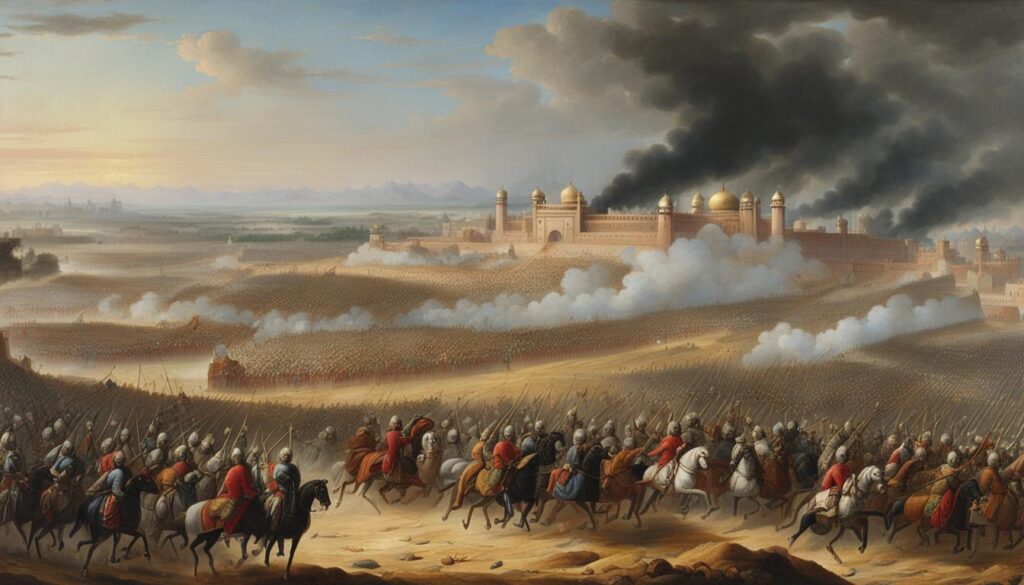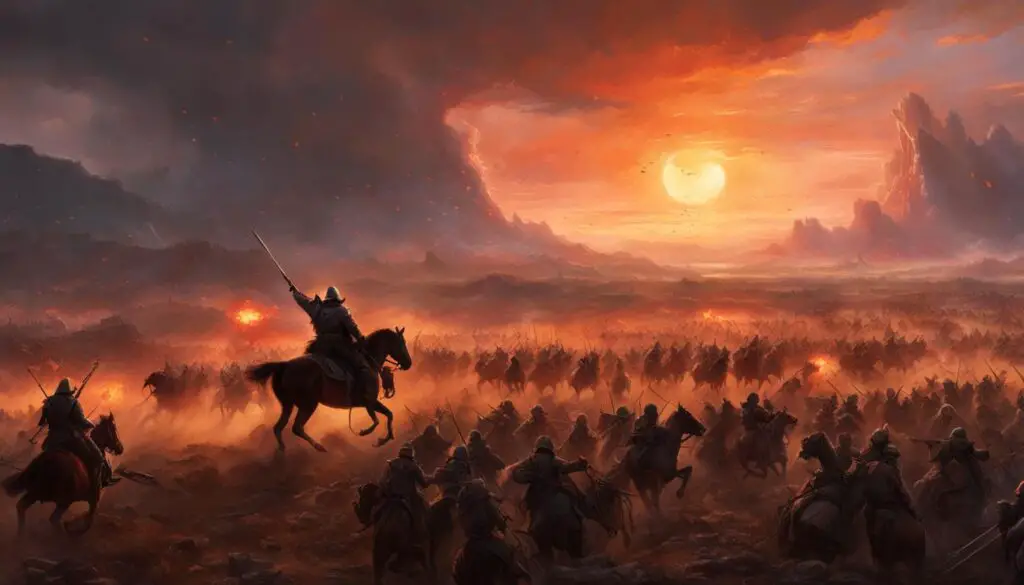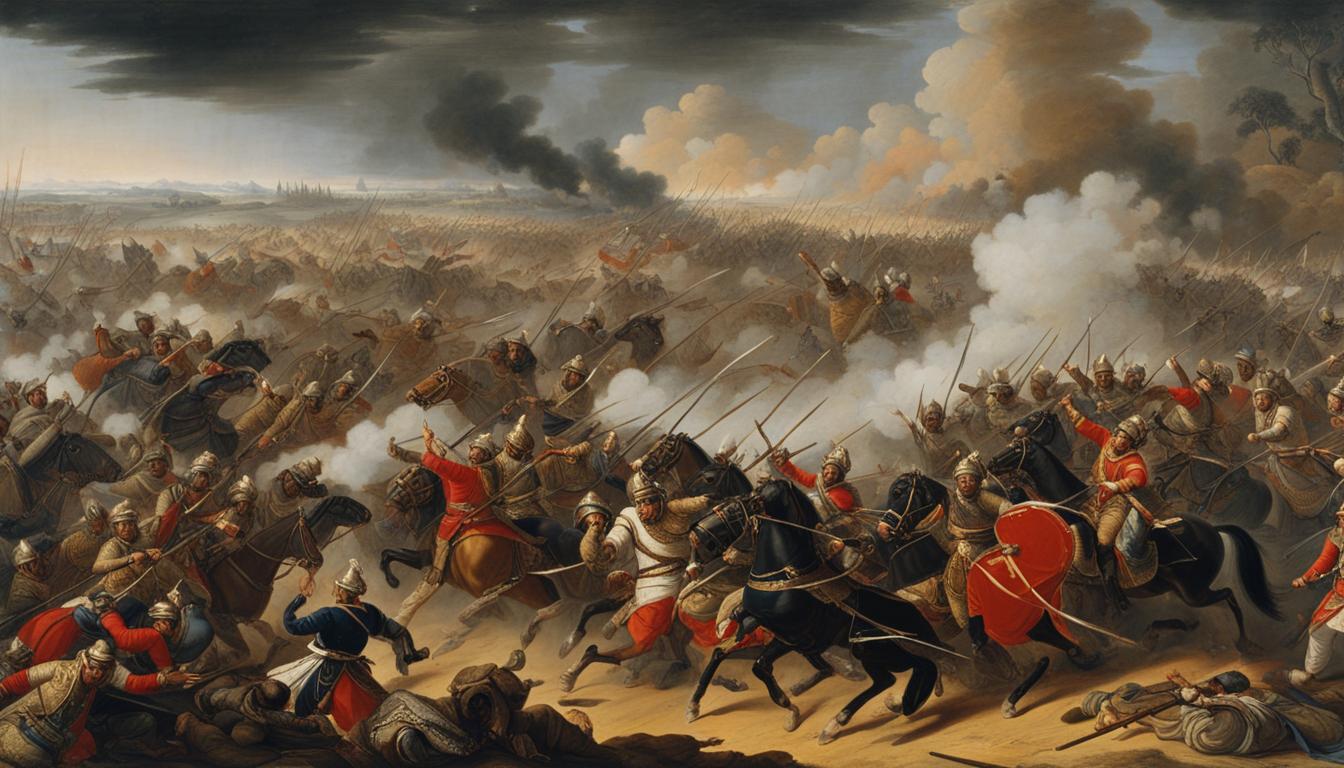Have you ever wondered about the turning point in Indian history that led to the rise of the Mughal Empire? Or the significant battles that determined the fate of the Delhi Sultanate? Look no further! In this article, we dive into the Battle of Panipat, a pivotal event that shaped the course of Indian history.
The Battle of Panipat, fought on April 21, 1526, pitted Babur, the ruler of Fergana and a descendant of Timur and Chengiz Khan, against Ibrahim Lodhi, the last Sultan of Delhi. This historic clash took place in Panipat, a city located in present-day Haryana, India.
Babur, invited by Daulat Khan, the governor of Punjab, sought to overthrow Ibrahim Lodhi and establish his own rule. What followed was a fierce contest of power, strategy, and military might. In a surprising turn of events, Babur emerged victorious despite being outnumbered by Lodhi’s forces.
What were the key factors that led to Babur’s triumph? How did this battle unfold, and what were its long-term implications for India? Join us as we explore the key facts and insights surrounding the Battle of Panipat.
Key Takeaways:
- The Battle of Panipat took place on April 21, 1526, between Babur and Ibrahim Lodhi.
- Babur’s better organization and use of gunpowder firearms and field artillery played a crucial role in his victory.
- The battle marked the end of the Lodi Dynasty and the Delhi Sultanate, paving the way for the establishment of the Mughal Empire.
- Babur’s victory at Panipat set the stage for future Mughal rule in India, shaping the country’s political and cultural landscape.
- The Battle of Panipat is regarded as one of the most decisive battles in Indian history, with far-reaching consequences for the subcontinent.
The First Battle of Panipat: Babur’s Victory
The First Battle of Panipat was a significant event in Indian history, marking the establishment of the Mughal Empire under the leadership of Babur. Fought between Babur’s forces and Ibrahim Lodi’s forces, this battle showcased Babur’s military prowess, artillery skills, and tactical brilliance.

Babur’s troops had a distinct advantage owing to their mastery of artillery skills and the introduction of gunpowder firearms and field artillery to the subcontinent. This technological superiority played a crucial role in Babur’s victory.
Babur’s tactical genius was evident in his careful planning and execution. He employed the strategy of Tulughma, the division of his army into different units, allowing for greater flexibility and coordination on the battlefield. Additionally, Babur utilized the Araba, a type of cannon, to devastating effect, launching powerful cannon fire at Lodi’s army.
Babur’s victory at the First Battle of Panipat had far-reaching consequences and laid the foundation for the Mughal Empire’s rule in India.
By defeating Ibrahim Lodi’s numerically superior army, Babur established himself as a formidable ruler and paved the way for the Mughal Empire’s dominance over the Indian subcontinent for centuries to come.
The Second Battle of Panipat: Hemu vs. Akbar
In 1556, an epic battle unfolded at Panipat between the Hindu ruler Hemu and the Mughal Empire led by Akbar. This confrontation, known as the Second Battle of Panipat, showcased the clash of military forces and tactics employed by both sides.
Hemu commanded a formidable army consisting of well-trained horsemen and war elephants, symbolizing his strength and power on the battlefield. Meanwhile, Akbar’s Mughal army, renowned for its military prowess, was equipped with field artillery guns, which played a decisive role in shaping the outcome of the battle.
The Role of Hemu’s Military Force
Hemu’s forces possessed a strong cavalry, which enabled them to maneuver swiftly and impact the battlefront with their sheer speed and ferocity. The war elephants deployed by Hemu added a formidable presence, instilling fear in the enemy ranks and disrupting their formations.
Akbar’s Strategic Tactics
On the other hand, Akbar’s Mughal army employed strategic tactics that showcased their astute military planning. By leveraging their field artillery guns, they unleashed devastating firepower upon Hemu’s forces, inflicting significant damage and disarray in their ranks.
A crucial moment arose in the battle when Hemu himself was struck by an arrow, rendering him unconscious. This turn of events shattered the morale of Hemu’s army and provided Akbar’s Mughals with a critical advantage. Seizing the opportunity, the Mughals pressed forward, utilizing their tactical expertise to secure victory.
Akbar’s triumph in the Second Battle of Panipat not only demonstrated his military acumen but also solidified Mughal control over North India, marking a significant turning point in the region’s history.
| Hemu’s Military Force | Akbar’s Strategic Tactics |
|---|---|
| Well-trained horsemen | Utilization of field artillery guns |
| War elephants | Devastating firepower |
With Hemu incapacitated and the Mughals employing their superior military force and tactical prowess, Hemu’s defeat was inevitable. The Second Battle of Panipat stands as a testament to the Mughal Empire’s expanding dominance in India, shaping the course of history in the region.

The Third Battle of Panipat: Marathas vs. Afghans
The Third Battle of Panipat, fought in 1761, was a significant confrontation between the Maratha Empire and the Afghan forces led by Ahmad Shah Durrani. Ahmad Shah aimed to defend the eastern imperial boundaries of the Durrani Empire from the growing power of the Marathas, who sought to expand their dominion.
The battle was characterized by an extended siege, during which the Marathas faced a shortage of food and supplies in their camp. Despite their efforts to cut off the enemy’s provisions, the Marathas decided to march towards Delhi, hoping to secure a strategic advantage in the region.
Ultimately, the Third Battle of Panipat resulted in a resounding victory for the Afghan forces. This victory had far-reaching political and military consequences for the subcontinent, as it significantly weakened the Maratha Empire and its ambitions for further expansion. The outcome of the battle shifted the balance of power in the region and reshaped the political landscape of India.
FAQ
When did the Battle of Panipat take place?
The Battle of Panipat took place on April 21, 1526.
Who were the main forces involved in the First Battle of Panipat?
The forces involved in the First Battle of Panipat were Babur’s troops and Ibrahim Lodi’s forces.
What advantages did Babur’s troops have in the First Battle of Panipat?
Babur’s troops had the advantage of artillery skills and introduced gunpowder firearms and field artillery to the subcontinent.
What tactics did Babur use to win the First Battle of Panipat?
Babur used tactics such as Tulughma (division of the army) and Araba (launching cannon fire) to defeat Ibrahim Lodi’s army.
When did the Second Battle of Panipat take place?
The Second Battle of Panipat took place in 1556.
Who were the main forces involved in the Second Battle of Panipat?
The main forces involved in the Second Battle of Panipat were Hemu and the Mughal Empire under Akbar.
How was Hemu defeated in the Second Battle of Panipat?
Hemu was defeated due to an arrow injury that rendered him unconscious and the strategic tactics employed by Akbar’s Mughal army.
When did the Third Battle of Panipat occur?
The Third Battle of Panipat occurred in 1761.
Who were the main forces involved in the Third Battle of Panipat?
The main forces involved in the Third Battle of Panipat were the Maratha Empire and the Afghan forces led by Ahmad Shah Durrani.
What were the consequences of the Third Battle of Panipat?
The Third Battle of Panipat had fateful political and military consequences for the subcontinent.
Source Links
- https://byjus.com/free-ias-prep/this-day-in-history-apr21/
- https://www.linkedin.com/pulse/today-history-the-battle-panipat-its-geopolitical-minister-jalali
- https://leverageedu.com/discover/general-knowledge/indian-history-battle-of-panipat/
